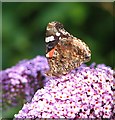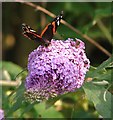1
New housing on Maurecourt Drive
Image: © Evelyn Simak
Taken: 11 Nov 2018
0.06 miles
2
New housing at The Pastures
Image: © Evelyn Simak
Taken: 11 Nov 2018
0.07 miles
3
The Pastures
A new housing development in Brundall.
Image: © Evelyn Simak
Taken: 11 Nov 2018
0.08 miles
4
The Pastures
A new housing development in Brundall.
Image: © Evelyn Simak
Taken: 11 Nov 2018
0.10 miles
5
New housing off Cucumber Lane
Image: © Evelyn Simak
Taken: 11 Nov 2018
0.10 miles
6
New war memorial in Brundall
This war memorial is located beside the entrance to the cemetery off Cucumber Lane and was unveiled by General the Lord Dannatt at a dedication ceremony in Brundall on 10 November 2018. The stone carries the words of the poem "Lest we Forget". A commemorative bench > http://www.geograph.org.uk/photo/5971797 donated by The Royal British Legion (Brundall & District branch), was placed alongside it.
Image: © Evelyn Simak
Taken: 11 Nov 2018
0.10 miles
7
Buddleia
This shrub is also known as summer lilac, butterfly-bush, or orange eye, and native to Sichuan and Hubei provinces in central China and Japan. It was first introduced to Europe in the late 19th century and can be found in many gardens although it is actually classified as an invasive species and apparently is a problem on British railways where it interferes with overhead power lines and obscures signals. Buddleia is recommended by butterfly conservationists because it is a valuable source of nectar for butterflies and other insects.
Image: © Evelyn Simak
Taken: 8 Jul 2017
0.10 miles
8
Buddleia
This shrub is also known as summer lilac, butterfly-bush, or orange eye, and native to Sichuan and Hubei provinces in central China and Japan. It was first introduced to Europe in the late 19th century and can be found in many gardens although it is actually classified as an invasive species and apparently is a problem on British railways where it interferes with overhead power lines and obscures signals. Buddleia is recommended by butterfly conservationists because it is a valuable source of nectar for butterflies and other insects.
Image: © Evelyn Simak
Taken: 8 Jul 2017
0.10 miles
9
Red Admiral butterfly (Vanessa atalanta) on Buddleia
Red Admirals are commonly found in damp environments such as marshes, woods, fields, and well-watered gardens. These butterflies cannot stand extreme winter cold and migrate southwards during the winter months to warmer climates. During their migration they can be found in habitats ranging from subtropics to tundras.
Buddleia is also known as summer lilac, butterfly-bush, or orange eye, and native to Sichuan and Hubei provinces in central China and Japan. It was first introduced to Europe in the late 19th century and can be found in many gardens although it is actually classified as an invasive species and apparently is a problem on British railways where it interferes with overhead power lines and obscures signals. Buddleia is recommended by butterfly conservationists because it is a valuable source of nectar for butterflies and other insects.
Image: © Evelyn Simak
Taken: 8 Jul 2017
0.10 miles
10
Red Admiral butterfly (Vanessa atalanta) on Buddleia
Red Admirals are commonly found in damp environments such as marshes, woods, fields, and well-watered gardens. These butterflies cannot stand extreme winter cold and migrate southwards during the winter months to warmer climates. During their migration they can be found in habitats ranging from subtropics to tundras.
Buddleia is also known as summer lilac, butterfly-bush, or orange eye, and native to Sichuan and Hubei provinces in central China and Japan. It was first introduced to Europe in the late 19th century and can be found in many gardens although it is actually classified as an invasive species and apparently is a problem on British railways where it interferes with overhead power lines and obscures signals. Buddleia is recommended by butterfly conservationists because it is a valuable source of nectar for butterflies and other insects.
Image: © Evelyn Simak
Taken: 8 Jul 2017
0.10 miles











